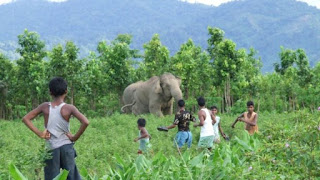 |
| Human-elephant conflicts in India, indpaedia.com |
 |
| elephant attack. killed 369 people in Odisha since 2015. indiatoday.com |
 |
| Elephants and tigers kill one human a day. Govt. data times of India.com |
 |
| Angry elephant. colourbox.com |
 | ||
| Crop raider in Jharkhand state .bbc.com/ |
 |
| Elephant in rage. .istockphoto.com |
Shrinkage of habitat or habitat loss may trigger ripple effects leading to crop raiding, injuries and deaths to humans by elephants. In Tamil Nadu in places like Coimbatore district, the elephants raid crops close to the villages and sometimes raid the houses as well looking for food, water, etc. So, the people in the fringe areas of the wooded places are living in constant fear of being attacked by the elephants. Pachyderms in groups raid banana, jack fruit plantations, etc and cause heavy financial loss to the small farmers who own less than 10 acres and eke out living on a small budget. Crop damages sometimes run into a few thousand dollars to millions of dollars. Every year, 100 humans (in some years it may be 300 people) and 40-50 elephants are killed during crop raiding in India. Yet another fact is both endangered elephants and tigers are killing a person a day.
Humans kill elephants for reasons of destruction of their properties and not for the reason of securing the ivory. Plantation workers in remote places feel the big animals are a threat to their lives and livelihood. So, they take the extreme step of retaliation against them which is a sign of human arrogance and dominance. In NE India more than 60 elephants were found dead in the recent past and this was due to retaliation against the elephants by the locals. They were on the look out for food for survival in the wake of fragmentation of their habitast.
It is to be borne in mind serious efforts should be taken to minimize the confrontation between elephants and humans to contain death on both sides and steps need to be taken for the conservation of Asian elephants and their habitat. Why do elephants raid the crops? There may be many reasons, but one fact emerges from the studies; they prefer raiding crops to feeding on wild forage because of their higher nutritive content and palatability. Studies also point out that not all elephants in a population raid the nearby crops. Only fragmented landscapes with no contiguous area with wide range may force the entire elephant population to move out looking for water and food. Deforestation, degradation of landscapes cause food loss and scarcity of water. The habitat loss may have a heavy toll on the animals that need lots of food and water for survival and they are driven to desperation.
The government must take careful steps to preserve the elephant habitats and safeguard the corridors through which they migrate from one region to another to mitigate the loss of humans and animals. Of course, the growing human population is squeezing the habitats of animals, as a result, the conservationist have a challenging job ahead and they have control deaths on both sides
http://wwf.panda.org/knowledge_hub/endangered_species/elephants/asian_elephants/areas/issues/elephant_human_conflict/
http://timesofindia.indiatimes.com/articleshow/60091086.cms?utm_source=contentofinterest&utm_medium=text&utm_campaign=cpps
https://www.bbc.com/news/world-asia-india-40899987









